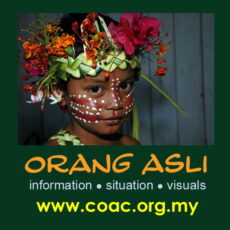About The Orang Asli
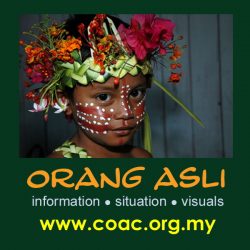
The Orang Asli of Peninsular Malaysia
Colin Nicholas
Center for Orang Asli Concerns
The Orang Asli are the indigenous minority peoples of Peninsular Malaysia. The name is a Malay term which transliterates as ‘original peoples’ or ‘first peoples’. It is a collective term introduced by anthropologists and administrators for the (officially) 18 ethnic subgroups generally classified for official purposes under Negrito, Senoi and Proto-Malay. They numbered 178,197 in 2010 representing a mere 0.6 per cent of the national population (28 million).
Classifications and Locations
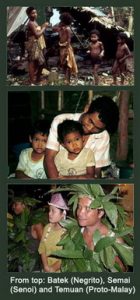 The Orang Asli, nevertheless, are not a homogeneous group. Each has its own language and culture, and perceives itself as different from the others. Linguistically, some of the northern Orang Asli groups (especially the Senoi and Negrito groups) speak languages – now termed Aslian languages – that suggest a historical link with the indigenous peoples in Burma, Thailand and Indo-China.
The Orang Asli, nevertheless, are not a homogeneous group. Each has its own language and culture, and perceives itself as different from the others. Linguistically, some of the northern Orang Asli groups (especially the Senoi and Negrito groups) speak languages – now termed Aslian languages – that suggest a historical link with the indigenous peoples in Burma, Thailand and Indo-China.
The members of the Proto-Malay (or Aboriginal Malay) subgroups, whose ancestors were believed to have migrated from the Indonesian islands to the south of the peninsula, speak dialects which belong to the same Austronesian family of languages as Malay, with the exceptions of the Semelai and Temoq dialects (which are Austroasiatic).
The Orang Asli have equally varied occupations and ways of life. The Orang Laut, Orang Seletar and Mah Meri, for example, live close to the coast and are mainly fishermen. Some Temuan, Jakun and Semai people have taken to permanent agriculture and now manage their own rubber, oil palm or cocoa farms.
Of the 869 Orang Asli communities in the peninsula, 37.2 per cent are in interior/forest areas while 61.4 per cent are in forest-fringe or rural areas. Only 1.4 per cent of the Orang Asli settlements are in, or close to, urban centers. Many of the communities living live close to, or within forested areas – including Semai, Temiar, Chewong, Jah Hut, Semelai and Semoq Beri – still engage in swiddening (hill rice cultivation) and do some hunting, fishing and gathering. These communities also trade in petai, durian, rattan and resins to earn cash incomes.
A very small number, especially among the Negrito groups (such as Jahai and Batek) are still semi-nomadic, preferring to take advantage of the seasonal bounties of the forest. A significant number of Orang Asli also have salaried jobs or are self-employed.
Nevertheless, one fact remains the same for all Orang Asli: they are the descendants of the earliest inhabitants of the peninsula and they have retained much of their identity which is distinct from the mainstream society.
Early Traders
This is not to suggest that the Orang Asli lived in complete isolation, existing only on subsistence production. Economic dealings with the neighbouring Malay communities were not uncommon for the past few hundred years, especially for the Proto-Malay groups. The Senoi and Negrito groups living in remote forest areas also engaged in some trading in the past, exchanging jungle produce for salt, knives and metal axe-heads.
There was also evidence of trade in blowpipes and blowpipe-bamboo among some Orang Asli groups. It has also been shown that the Orang Asli have played a significant role in the Malay Peninsula’s economic history as collectors and primary traders as early as the 5th Century CE.
There seemed, therefore, to be a certain amount of interaction between the Orang Asli and the other ethnic groups, particularly the Malays who resided along the fringes of the forest. Some of the initial contacts, however, were unfortunately characterized by cruelty and mutual hostility.
Slavery
Slave raids into Orang Asli settlements were not an uncommon feature in the 18th and 19th centuries. The slave-raiders were mainly Malays and Bataks, who considered the Orang Asli as ‘kafirs’, ‘non-humans’, ‘savages’ and ‘jungle-beasts.’
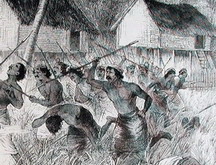 The modus operandi was basically to swoop down on a settlement and kill off all the adult men. Women and children were preferred as they were less likely to run away and were ‘easier to tame’. The Orang Asli slaves were sold off or given to local rulers and chieftains to gain their favour.
The modus operandi was basically to swoop down on a settlement and kill off all the adult men. Women and children were preferred as they were less likely to run away and were ‘easier to tame’. The Orang Asli slaves were sold off or given to local rulers and chieftains to gain their favour.
A considerable trade in slaves thus soon developed – and even continued into the last century despite the official abolition of all forms of slavery in 1884. In fact, the derogatory term Sakai used to refer to the Orang Asli until the middle of this century was often taken to mean ‘slave’ or ‘dependent’. Many Orang Asli elders still remember this sad period of their history, and all Orang Asli detest being called Sakai.
Specimens and Souls
The coming of the British administrators led to some outcry against the slavery of the Orang Asli, but there were no efforts to promote their welfare. Because of their ‘primitiveness’ and their ‘uncivilized culture’, Orang Asli were regarded as excellent subjects for anthropological research. That the Orang Asli were seen so can be gleaned from the fact that the earliest official act directed towards the Orang Asli was the setting up of the Perak Museum in Taiping, from where research into Orang Asli demography and ethnography was to be carried out.
Also, being regarded as ‘uncivilized’ and therefore, it follows, ‘unsaved’, placed the Orang Asli in good light for the zeal of missionary proselytizers. The Catholics began their missionary activities among the Temuans in the middle of the 19th Century. The Methodists started theirs in the 1930s. Bahai missionaries also had a following in the 1960s while Muslim missionary work began in the 1950s and became increasingly more active over the last two decades.
Interest in the Orang Asli therefore tended to revolve around their usefulness as anthropological curiosities or as convenient subjects for proselytization. Otherwise, the official attitude towards the Orang Asli was one of indifference and one where it was a matter of “having other more important things to worry about”.
Protection
Until the late 1940s, there was no specific administration for the Orang Asli, but it became regarded as a responsibility of the Taiping Museum Curator to concern himself with research among the Orang Asli in Perak. The Orang Asli continued to be regarded as noble savages, leading an idealized and romantic existence; the task of government being to protect and preserve them from the ravages of civilized life.
A rather detailed report in 1936 by H.D. Noone, then the field ethnographer (and later, Director) of the Perak Museum at Taiping, sought to perpetuate the view of the British colonialists that the Orang Asli should remain in isolation from the rest of the Malayan population, and be given protection.
Noone called for the establishment of large aboriginal land reservations where the Orang Asli would be free to live according to their own tradition and laws. Noone also proposed the creation of “patterned settlements” in less accessible areas, where the Orang Asli could be taught agricultural skills. He also sought the encouragement and development of aboriginal arts and crafts, and the creation of other forms of employment among the Orang Asli. Several protective measures were also proposed, such as the banning of alcohol in Orang Asli reserves and the controlled peddling of wares.
Although not implemented by the government of the day, his ‘Proposed Aboriginal Policy’ did however lay the groundwork for future government policy towards the Orang Asli.
The Emergency
The Orang Asli were insignificant players in the Malayan political sphere – that is, until the Malayan Emergency began. This was Malaya’s civil war between the Colonial government and the communist insurgents from 1948 to 1960.
In the early years the insurgents received much help and supplies from (mainly Chinese) sympathizers in the rural areas. However, the Brigg’s Plan, which involved relocating much of the rural population into closely-guarded ‘new villages’, successfully cut the link between these two groups. Consequently, the insurgents were forced to operate from areas in deep forests, where they sought the help of the Orang Asli. Some Orang Asli were known to provide food, labour and intelligence to the insurgents.
The Colonial Government quickly saw the importance of the Orang Asli in winning the war and created the post of Adviser on Aborigines. However, initial attempts at controlling the Orang Asli proved disastrous for both sides. In an attempt to prevent the insurgents from getting help from the Orang Asli, the British herded them into hastily-built resettlement camps. A few hundred Orang Asli died in these crowded and sun-baked camps mainly due to mental depression rather than disease. One former Director-General of the Department of Orang Asli Affairs (JHEOA) even claimed that up to 7,000 Orang Asli died in these resettlement camps.
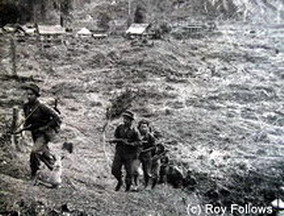 Later, realizing their folly, and recognizing that the key to ending the war lay in ‘winning over’ the Orang Asli to the government’s side, a Department of Aborigines was established and ‘jungle forts’ were set up in Orang Asli areas, introducing the Orang Asli to basic health facilities, education and basic consumer items.
Later, realizing their folly, and recognizing that the key to ending the war lay in ‘winning over’ the Orang Asli to the government’s side, a Department of Aborigines was established and ‘jungle forts’ were set up in Orang Asli areas, introducing the Orang Asli to basic health facilities, education and basic consumer items.
This period also saw the first important attempt at legislation to protect the Orang Asli. The Aboriginal Peoples Ordinance of 1954 (later amended in 1967 and 1974 to conform to changing conditions) was considered a milestone in the administration of the Orang Asli, for it indicated that the government had finally formally admitted its responsibility to the Orang Asli.
At about the same time, the Department for Aboriginal Affairs was enlarged in order to make it an effective force. But, as the former Commissioner for Orang Asli Affairs noted, the only reason for such re-organization was to ensure a better control over the Orang Asli and to make sure that they would have less inclination and few, if any, opportunities to support the insurgents.
Later, in an apparent reversal of the government’s policy towards the Orang Asli, the jungle forts were abandoned and replaced by ‘patterned settlements’ (later to be called ‘regroupment schemes’). Here, a number of Orang Asli communities were resettled in areas which were more accessible for the Department officials and the security forces and yet close to, though not always within, their traditional homelands. The schemes promised the Orang Asli wooden stilt houses as well as modern amenities such as schools, clinics and shops. They were also required to grow cash crops (such as rubber and oil palm) and practise animal husbandry so as to be able to participate in the cash economy.
Nevertheless, the strategy proved successful in that Orang Asli support for the insurgents waned. This waning support for the insurgents prompted massacres of Orang Asli who were thought to be on the government’s side. The Emergency formally ended in 1960. Alas, despite the important role the Orang Asli played in helping to end the Emergency, many books on this period do not acknowledge the fact.
More so, for the Orang Asli it spelled the beginning of a more active and direct involvement of the state into their affairs and lives.
